 |
|
 |
2022
July
31
|
559 songs
Avid readers will remember that last September, for my birthday, Melody gave me
8,700 MP3s (digital music files), mostly copied from our (her?) huge CD collection.
As a guided introduction, she also gave me a playlist of about 140 songs, which I
made into a pair of data CDs that we can play in our cars.
After letting her introduce me to her top 140, and exploring further, I decided to take
a deeper plunge. The other day I made a set of 4 data discs comprising 559 songs.
Unlike the first 140, these are not Melody's selection, they're my selection.
They include songs that evoke (for either her or me) memories going all the way back
to elementary school, all the way up to some very recent, enjoyable jazz instrumentals.
What's fun is that the songs are in close to random order.
My software alphabetized them by name — often including track numbers — which of
course mixed all the different musicians together.
So it's like having our own radio station that plays songs at random, but never plays
anything we don't like.
And in starting to play it, I realized something important:
I often enjoy a song more if there aren't other similar songs right next to it.
Albums are not the right way to enjoy songs that should stand on their own!
At least not always. If you're listening to several similar songs in a row,
you can, so to speak, be tired of the best song before you get to it.
Update: Our Ford stereo system only plays MP3s, not the occasional WMA and WAV files that
were interspersed in the collection. After converting everything to MP3s, which are smaller,
I found room for even more songs; the second edition of our personal 4-disk set now has
629 songs.
We have two goals. (1) To have disks that we can leave in the player for days and not get
tired of them, because the music is so varied. (2) For me to get better acquainted with music
that Melody likes and that I didn't listen to because, while busy with other things for many years, I just
wasn't taking in much music that I wasn't already familiar with.
It's a way of broadening my tastes and getting to know Melody better.
Permanent link to this entry


|
2022
July
30
|
Six more wives of Henry VIII
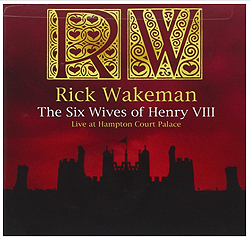 For the second time in 46 years, Melody and I have sat down together to
listen to a Rick Wakeman album.
The first was King Arthur, on my first visit to her at her parents' house
in 1976; tonight it's the Hampton Court version of
The Six Wives of Henry VIII.
For the second time in 46 years, Melody and I have sat down together to
listen to a Rick Wakeman album.
The first was King Arthur, on my first visit to her at her parents' house
in 1976; tonight it's the Hampton Court version of
The Six Wives of Henry VIII.
We've listened to a lot of music in between, of course, just usually not sitting side by side at home.
We were both fond of the original Six Wives (1972?), which, however, had flaws in the
performance and the recording, and wondered what the 2009 remake would be like.
I got hold of it, and today we listened to it together...
My impressions: The performance and recording are first-rate. The music is substantially changed, with three new
movements added (at least one of them composed back in the day, but not used then),
the six wives out of historical order (I haven't delved into why), and elaboration of
the existing music. "The Day Thou Gavest, Lord, Has Ended" is still there, at the end of "Anne Boleyn,"
no longer a separate track. The music is much more uniform from movement to movement in overall acoustic
quality, loudness, and style. Well worth listening to! But don't throw away your copy of the original,
which is a distinctly different work.
Permanent link to this entry


|
2022
July
28
|
Braselton again

One of the first things Melody and I did together, when we had first
started dating, was a photography excursion to Braselton.
On Tuesday (the 26th) we found ourselves in Braselton again, and I couldn't resist
photographing my sweetheart again in the same place:
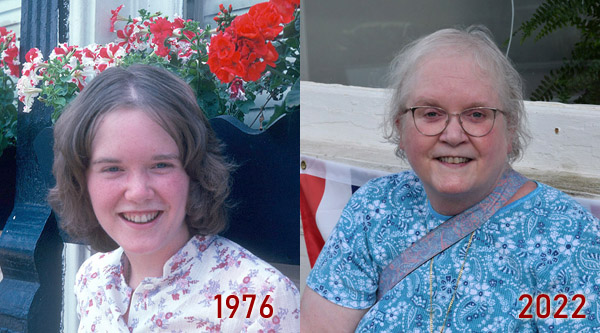
The setting had changed a little. It was in front of this store:

It was actually a store in 1976 but now houses several shops and restaurants.
The flower boxes are gone.
Most importantly, the pavement has been raised quite a bit;
the flower boxes were at head height in 1976, but in 2022 Melody
was sitting on a concrete ledge rather than standing up.
Behind the old store was some shrubbery, backlit by the sun, that caught
Melody's eye:

We were not re-enacting our 1976 trip to Braselton; we just happened to visit the same place.
Last week's drive to North Carolina (my first overnight trip away from home
since the pandemic) had whetted rather than sated my wanderlust,
and Melody and I took a drive just to get out of the house and see the
(increasingly urban) countryside. We went on 316 west to 53 and then on
53 through Winder and Braselton to Gainesville, then into Athens on 129.
One highlight of the trip — recalling also the 1976 trip — is that in 1975-76,
before we got together, Highway 53 was Melody's daily route to college.
(It's how she became aware of the picturesqueness of Braselton.)
She commuted from her parents' home in Winder to Gainesville Junior College,
which is now UNG Gainesville Campus.
And on this trip she finally was able to show it to me.
The campus is sprawling now and must have been very sprawling
when the college was smaller. Most of the buildings have been repurposed,
and many new buildings have been added in the same style, so Melody was not able
to point out very many familiar places. She did note that the administration building
used to be the student center, and the pond with the fountain was again, as of old,
being visited by migrating geese. It is always refreshing to revisit a place
where good things have happened to you, and for each of us, the first year of
college was a joyous opportunity to spread our intellectual wings after the
confinement of high school.
Of course, this wouldn't be a trip to Braselton without a meadow, although we
saw surprisingly little open country; our one and only meadow picture was
taken near Winder.
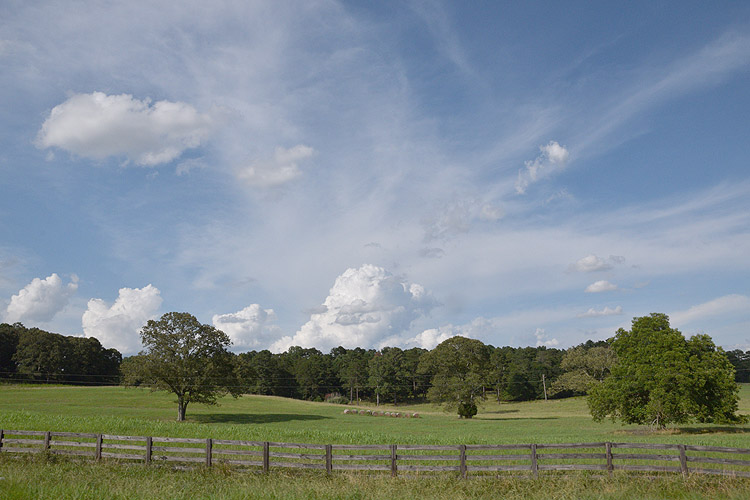
We made plans to go to Braselton again every 46 years, or sooner.
Permanent link to this entry


|
2022
July
25
|
40 years!
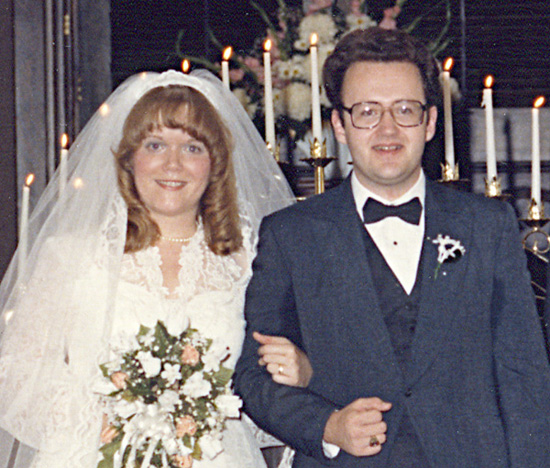
Blessed art Thou, Lord our God, who hast given us life and sustained us
and enabled us to reach this day!
Today Melody and I celebrate 40 solid years of happy marriage.
I joke that this means we have lasted 3,652 times as long
as Romeo and Juliet.
I've written a lot about what I think are the secrets of our happy marriage
(see for example this)
and have told, in great detail, the story of how we met at a UGA recruiting
event, the friendship ripened as we wrote letters back and forth,
and by the time Melody arrived on campus, she was the best friend I had ever had,
and from very soon afterward, my inseparable companion.
Melody was the first friend who understood what I was doing with my time, energy,
and life — why I got such enjoyment from learning things that were not
job training or commercial entertainment. I had gotten tired of people admiring my intellectual pursuits by saying,
"That's amazing, I could never do that." Melody had wide interests of her own
and knew that she could do anything she put her mind to. Nothing that I cared about
was a completely closed box to her, and vice versa. She understood.
What I can add is that we both feel as if we were together, in spirit, in some way
for a couple of years before we actually met. That is, we were becoming more and
more alike, and seeing more clearly what the ideal companion would be like —
and then we met. Life and God had been preparing us for each other.
Forty years are not long enough! Let's go for forty centuries!
Permanent link to this entry


|
2022
July
24
|
80 minutes of M27
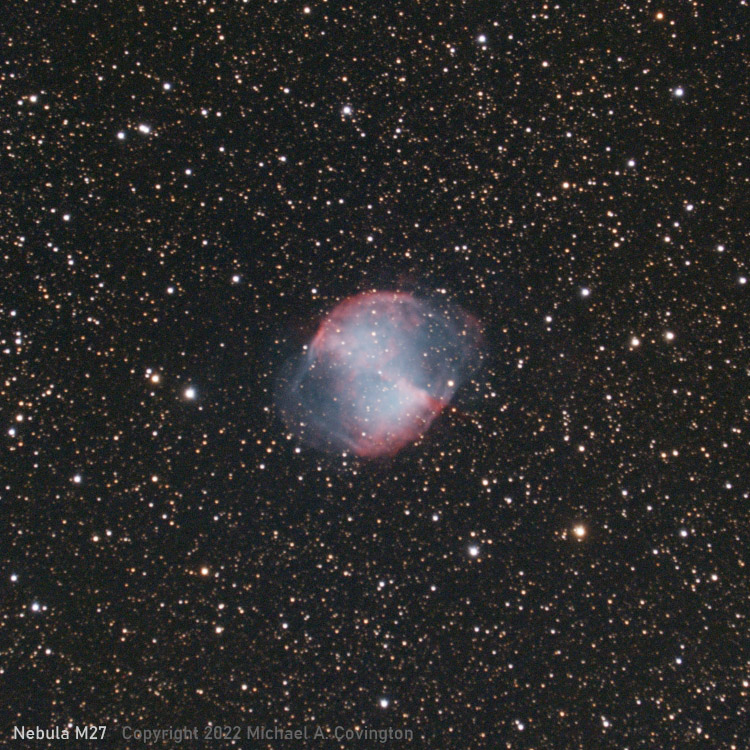
Here's my second astrophoto taken with the new Losmandy mount.
This is a stack of forty (yes, forty) 2-minute exposures through my Celestron 8 EdgeHD
at f/7 with an H-alpha-modified Nikon D5500.
This is the remains of a star that blew off its outer atmosphere; it's the same kind of
object as the Ring Nebula (below), but viewed edgewise.
Permanent link to this entry
News update
Sharon and I have just returned from North Carolina, where, for the first time, she was
examined by a research-level physician, who pinpointed the cause of her shoulder pain in a
way that had not been done before. It is probably going to be treated surgically.
She has three disorders overlaid on each other, one of which has already been treated
successfully, and there's a good chance that in five years she'll be substantially better.
Permanent link to this entry


|
2022
July
17
|
The Ring Nebula and a galaxy
First light with the new Losmandy GM811G
After three weeks of cloudy weather, I've finally had my new Losmandy telescope mount
out twice, once for a visual session and once to take pictures, last night.
I'm still confirming basic functionality and not yet attempting anything challenging.
Here's a stack of 16 2-minute exposures of the Ring Nebula (M57) with my
Celestron 8 EdgeHD at f/7 and Nikon D5500 (H-alpha modified):
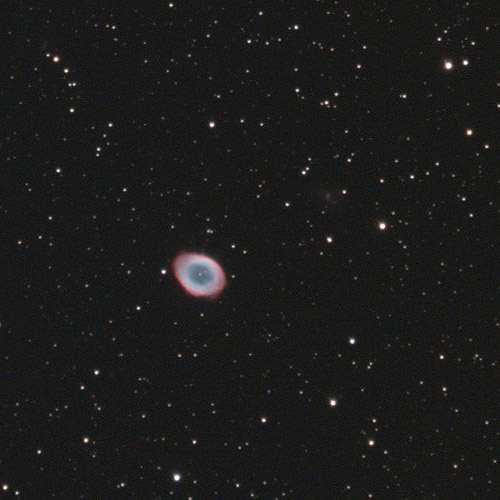
To the upper right of the nebula, you can see a faint smudge, which is the distant galaxy IC 1296.
Here's the same picture, processed lighter, to make it easier to see the galaxy:
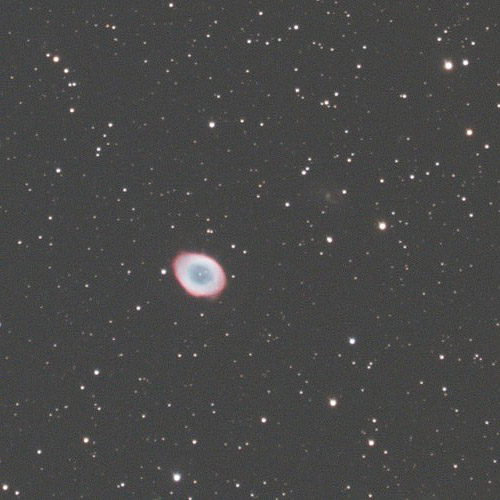
One thing that fascinates me about the astrophotography I'm doing these days is that almost
every picture shows background galaxies, some of them very poorly known to science.
Amateur astronomers of my era think of galaxies as a couple of hundred reasonably bright objects
we can see with our telescopes. No — as the James Webb Space Telescope has demonstrated,
the universe is full of them!
Permanent link to this entry
My father's 1950s stapler
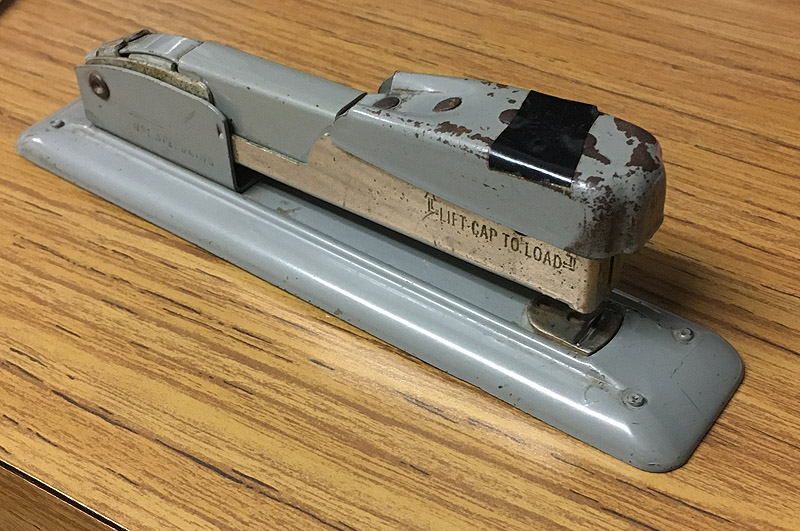
While tidying up my desk the other day, I found the stapler that had been on my father's
desk since the 1950s (I distinctly remember handling it in 1960), got it out, and put it
on my own desk. It's surprising how well it works.
The piece of black tape on it dates from the 1970s. I can't remember if it is covering
up a rusty spot, or if I just needed a place to put down a piece of tape for a moment,
then forgot about it and didn't come back for it. My Facebook audience has actually
debated whether I should leave it on. It's like leaving an 18th-century bookplate in a
16th-century book; it's part of history, though not the same history.
Permanent link to this entry


|
2022
July
11
|
The missing university
[Revised.]
Today, taking advantage of post-COVID conditions, I spent a couple of hours taking a long walk
on the UGA campus (all the way from the Georgia Center parking deck to the Arch, and then downtown
to Wuxtry Records to buy used CDs), and on the way back, paused in the Main Library.
It reinforced my impression that there are almost no regularly enrolled summer-term students here.
There were groups of incoming students at orientation, with their leaders, but very few people who
looked like regularly enrolled students. What happened?
What I've found out is that online courses are displacing classroom courses, at least during
the summer. There's plenty of enrollment, but it's for online instruction.
I have mixed feelings about that. Since the 1960s (yes, 1960s!) there has been speculation that
classrooms would be superseded by instruction through the Internet or, earlier, TV.
But it didn't happen.
Is COVID what it took to get people to stop wanting to gather for the college experience?
And if so, is that a good thing?
I can see how online courses can be a big money-saver — you can stay at home.
And some courses (mostly introductory ones, and drill-and-practice language courses) would
come through very well. Others, though, might benefit from more personal contact.
And some courses require hands-on experience in labs.
And more to the point, what about the experience of meeting people and learning to
communicate with them? Have young people suddenly lost their gregariousness?
And education spreads from person to person — maybe a third of what I learned in my Ph.D.
studies came laterally, from student to student!
What I think is that online instruction will continue to siphon off part of the student
body at any given time. It will slow down or reverse the growth of the resident-student
population without making the University go away. It will give students a way of peeling away
part of the cost, not having to be resident for four full years.
In the future I can imagine a different scenario.
Let the students gather at library/lab/study facilities near them
(which junior colleges could turn into) but study online at any university
that will take them.
The local facility could offer the companionship of like-minded students, at
least within some limits, and maybe some hands-on laboratory courses.
Major in physics at MIT while living in Georgia and
spending part of your days on the campus of Gainesville College,
maybe putting in one or two semesters of actual residence at MIT before getting the degree.
I'm not sure if I would like that kind of college experience, but it would certainly make
a good education more affordable.
If that's too much of a stretch, imagine a reasonably major university hosting online
students at other universities, and maybe allowing them to take some lab courses locally
and work with some local faculty members.
That could be a real paradigm shift.
Either way, online instruction may finally do for us what junior colleges promised
and did not quite achieve — make part of a major university education
much more affordable — because the online courses are offered by the major university
itself and have its full backing and prestige; you don't have to worry if they will be
accepted for transfer credit.
Permanent link to this entry


|
2022
July
9
|
Georgia Guidestones, 1980-2022
 Photo by Quentin Melson, used by permission, from Wikimedia
Photo by Quentin Melson, used by permission, from Wikimedia
The Georgia Guidestones were a Stonehenge-like structure outside Elberton, Georgia,
inscribed with instructions in many languages telling people (or, we were told at the time, space-alien visitors)
how to take care of the earth after some future apocalyptic calamity.
They were reportedly funded by an anonymous eccentric,
made by the local granite company, and eventually given to the local
government.
Melody and I went to see them in 1980, soon after they were built;
we heard about them from the linguist who had done one of the translations.
Our color slides from that day are packed up where I can't get to them, so I'm showing you a picture
from Wikipedia.
The Guidestones were seriously damaged by an explosion around 4 a.m. on July 6, and the remainder of the
structure was dismantled shortly afterward because it was about to fall.
As of now, nothing has been announced about the cause of the explosion, except that it was bomb placed by a human being,
not a lightning strike or mysterious explosion.
So what were the Georgia Guidestones?
Bearing in mind that there was little fringe or extremist politics in 1980,
at the time the Georgia Guidestones were viewed as goofy but harmless, and they became a tourist
attraction.
Not everyone saw them that way. The actual inscription raised concerns from a few people at the time
the stones were unveiled, snowballing to very strong objections from some right-wing groups today. Here are
the instructions on the Guidestones:
It is hard to tell whether these reflect deep thought or just a collection of ideas from
the science fiction and popular culture of the time.
Some are uncontroversial (5, 7, 8); some sound like 1970s humanism (4, 9, 10)
or futurism (3, 6); but look at the first two.
Who is supposed to maintain the population at less than 1/10 its current total,
and how are they supposed to regulate it?
Any regime actually trying to do those things would be intolerable.
The other thing that is disconcerting about the Georgia Guidestones is their anonymous origin.
The donor, "R. C. Christian," did not use his real name, and it's unclear whether it was
one person or a group. There has been a tremendous amount of speculation, more than the evidence
can possibly justify, and I don't want to follow that rabbit-trail here.
To be clear: I don't condone the bombing of the Guidestones, nor the vandalism to which
they had been subjected earlier. Foolish ideas should be refuted, not silenced.
But I cannot uphold the Guidestones as an example of great wisdom.
And — without joining those who speak in exaggerations and raise undue alarm —
I want to say that I am uneasy about the role the local government had in maintaining and
promoting them — as if the donation were a way to trick the local government into
continuing to advertise someone's strange ideas.
Permanent link to this entry


|
2022
July
6
|
So you want to write the history of popular music?
[Revised several times.]
Lots of people on YouTube try to expound the history of popular music or rock music. Far be it from me to claim to know their field. But I do have a couple of observations.
(1) Not everything was important or great. If you can't distinguish levels of importance, you're not doing history.
Large sets of brief anecdotes or incidents are also not history, although they can be data for history.
(2) Because of the way the mass media worked in the 1960s and 1970s,
something got a huge audience every week, whether it was good or not.
Something had to be at the top of the charts at any given time.
We had only 3 TV networks, and almost all the radio stations followed the same Top 40 chart.
The handful of songs at the top of the chart each week were heard by everybody everywhere.
In fact, I think one thing that fascinates people about 1960s and 1970s music is that in any given week,
the entire nation was listening to the same songs, so the songs are good at bringing back memories
of specific times. It even gives us an indirect reason for liking songs that don't impress us as music;
they are the soundtracks of our memories, down to the specific month or even week.
Popular music doesn't work that way any more.
I've written about the large-audience effect before.
Back in 1964, one third of the U.S. population (including me) saw the Beatles' debut on
The Ed Sullivan Show. Sixty million people. Does that mean the Beatles were the greatest
musicians the world had ever seen? No, only that the media arranged to herd an unprecedented number of
people into one audience.
And the large-audience effect actually creates a conundrum for historiographers.
If something is not great, but the media expose a huge number of people to it and tell them to like it,
doesn't that mean it has had historical importance thrust upon it?
After all, it is widely known and has a large ability to influence others (a key aspect
of historical importance); it just isn't great.
(3) One other observation. Low audio quality played a large role in 1960s-1970s
popular music, as did circumstances in which we didn't hear a song well.
Good stereo systems (even as good as your pocket MP3 player)
were uncommon back then, and good headphones didn't exist.
Music on AM radio always had the treble and bass cut by the limited bandwidth of the radio.
Music on TV was even worse — if you closed your eyes while watching musicians on TV,
you'd realize you were hearing something very tinny and muffled.
As for circumstances, we often heard songs on a radio that was playing in the background
in a public place or (most often) in a car, not giving it our full attention; the DJ might
even be talking over the music.
This favored songs that didn't lose much when the audio quality was low — songs in the
middle of the audio range, with fairly constant volume throughout.
It also favored songs that were easy to recognize from brief passages.
And it led people to like songs without having listened closely to every word;
there were occasional surprises!
Here's an example. Loggins and Messina's hits were "Danny's Song,"
"House at Pooh Corner," and "Your Mama Don't Dance." Those are three songs that do not much
resemble each other nor the rest of Loggins and Messina's work. From them, you'd hardly
know what kind of music Loggins and Messina regularly produced — songs almost like folk songs, with
elaborate instrumental passages — songs that aren't catchy when you hear them poorly
and in fragmentary form, but are (to my taste) much better than the hits.
In particular, "Your Mama Don't Dance"
has exactly the sound that is needed to
make the Top 40; it is recognizable from short passages and doesn't require clear audio.
And it has another Top 40 ingredient: adolescence.
Maybe they decided to make a hit song by following the formula.
Permanent link to this entry


|
2022
July
4
|
A calculator I like
About 15 years ago I standardized on the Casio FX-115 calculator and even
made a reference card for it.
I ended up owning four of them, so I can reach for a familiar calculator
everywhere I work.
That was then; this is now. Today I'm switching to the
Sharp EL-531.

Why? Because the functions I need are right on the main keyboard,
not nested in menus.
To get into hex mode, I don't press MODE MODE 3, I press the shift key
and then the key with HEX above it.
I had never been using the hex mode on the Casio because I couldn't remember
how to get to it!
Besides hex and binary, the Sharp has handy things like degrees-minutes-seconds
vs. decimal degrees, again right there where you can see it.
I thought a selling point of the Casio was the log-to-any-base function,
since I use logarithms to base 2 a lot, but actually, it's no more work to
enter log X ÷ log 2 than log 2 , X because the comma is a two-keystroke
character. And that method works on all calculators, not just Casios.
Key idea here: I don't want a calculator that does everything.
I always have a computer nearby.
The calculator is for doing quick calculations on the side.
I always work with a computer and a calculator and a pen
and pad of paper. Does that smack of the twentieth century?
Maybe, but it works.
Permanent link to this entry
A cause of "router rot" identified
Some years ago I hypothesized that
"router rot" was caused by power supply degradation.
"Router rot" is the gradual loss of reliability of network routers and the like,
where it starts hanging and needing to be rebooted every few days or more often.
Yesterday our old Linksys (Cisco) E3000, which was doing service as an access point,
started showing symptoms, and I decided to investigate.
My first discovery was that we didn't need it; newer laptops get better Wi-Fi reception,
and all our devices now have no trouble getting into the main router upstairs.
I found that the wall-plug power supply was apparently within specification, but on a hunch,
I opened up the E3000 (which involved going online and finding out how to crack the plastic case),
then removed the main filter capacitor (1000 µF, 25 V).
It tested approximately 500 µF with 0.19 ohm series resistance, which is way out of spec.
And it's a capacitor of a brand I've not heard of, whose very name inspires suspicion.
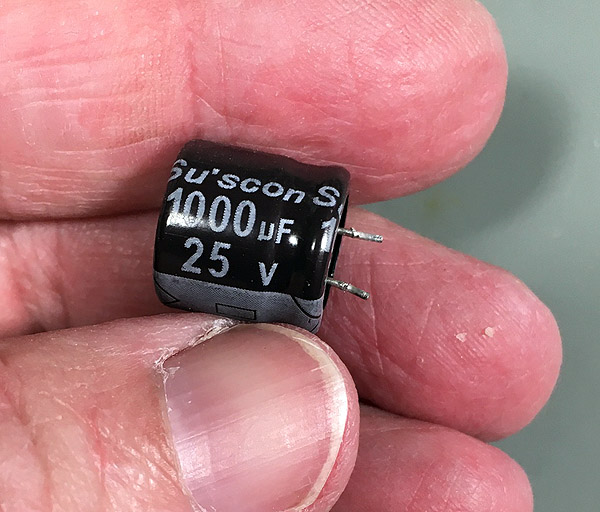
Unfortunately, while replacing it I damaged the circuit board, and since this was not a
valuable piece of equipment, I decided not to spend time trying to fix the board by
microsoldering. But I got some valuable experience and information.
At least in this case, it was a deteriorating power filter capacitor,
the most failure-prone component inside the case.
[Update:] I got the capacitor replaced successfully, but the router still
does not pass its power-on self-test. I will experiment with it a little more.
Permanent link to this entry
Everybody's out of town and the restaurants are closed
This is many people's first big holiday weekend since the pandemic.
The Red and Black reports that some restaurants are taking
the whole week off.
Today we found out the hard way that a lot more of them are closed
or keeping reduced hours just for today.
I took Melody out for both lunch and dinner.
Both ran into complications.
At lunch, Arby's, La Parrilla, and Dos Palmas were closed;
we ended up at Chick-Fil-A.
At dinner, Amici was closed and we ended up at Longhorn,
where I ate salmon and amused Melody by asking what a Longhorn fish
looked like.
Then we needed to pick up something to bring home for Sharon,
and Chick-Fil-A had closed early, nor was Panera open; at that point
she decided to make something in the kitchen.
I've enjoyed the long weekend. Tomorrow, back to work!
Permanent link to this entry


|
2022
July
3
|
Two photographs
Melody and I took the Nikon with us as we ran errands yesterday.
The most striking thing in our environment was dramatic clouds in the sky.
I took a rather simple picture,
inspired by paintings by our
friend Scott Pope:
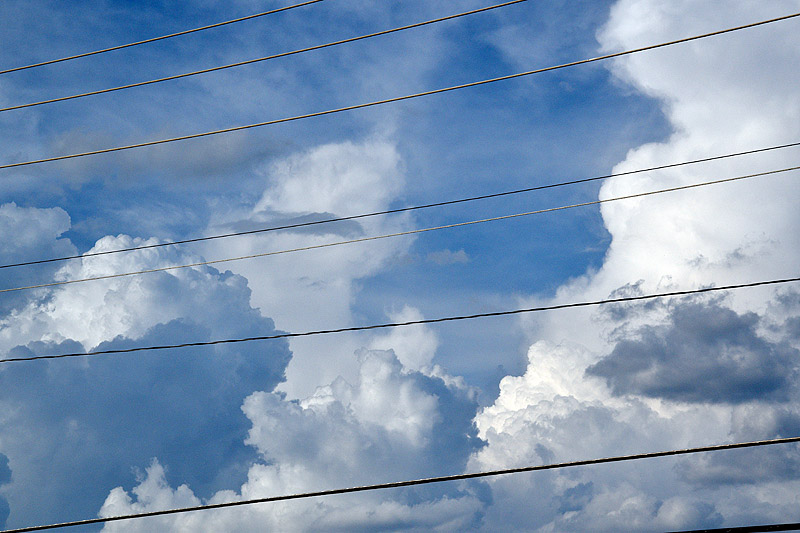
Then Melody photographed something more dramatic that I would never have noticed:
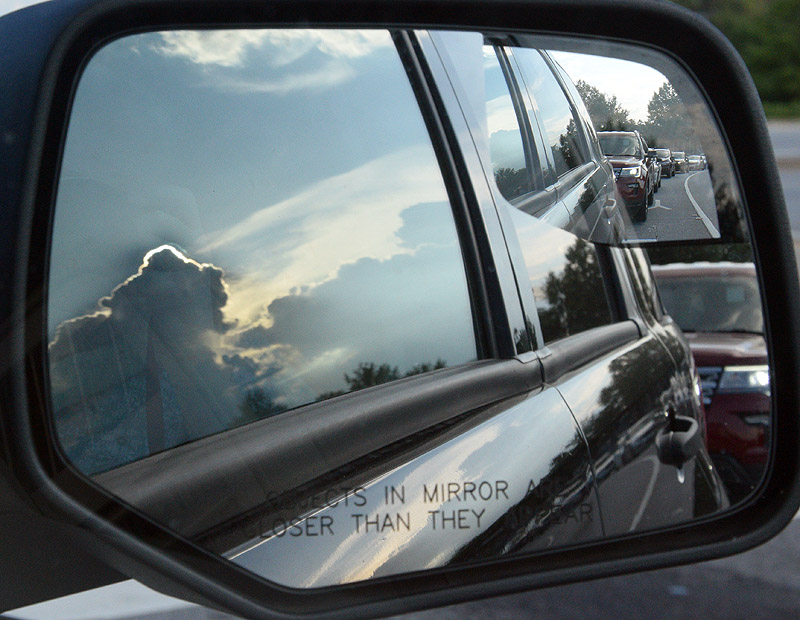
Nikon D5300, 18-105mm zoom lens.
Permanent link to this entry


|
2022
July
2
|
Luminous Nandina

This is one of Melody's Nandina plants in the front flowerbed;
also one of the first pictures taken with our new Nikon 18-105mm zoom lens
(on the D5300). I took this, but that camera and lens are Melody's usual art setup
these days. (I also used that camera and lens to photograph the stained glass
window the other day.)
Permanent link to this entry
Botanical mystery solved?
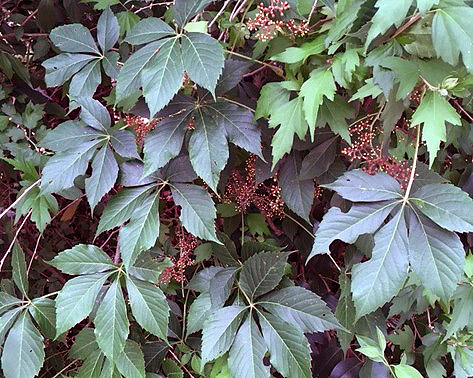
This plant is Virginia Creeper (Parthenocissus),
not poison oak or poison ivy (Toxicodendron).
So why have people been telling me occasionally, all my life long,
that it is poison oak or poison ivy?
The answer finally came my way, from several sources, the other day.
Virginia Creeper is not poison ivy but is able to give a lot
of people a rash. Many people get no reaction to it at all, but severe reactions
are apparently common enough to keep the message circulating.
Permanent link to this entry


|
| |

|
|
|
This is a private web page,
not hosted or sponsored by the University of Georgia.
Copyright 2022 Michael A. Covington.
Caching by search engines is permitted.
To go to the latest entry every day, bookmark
https://www.covingtoninnovations.com/michael/blog/Default.asp
and if you get the previous month, tell your browser to refresh.
Portrait at top of page by Sharon Covington.
This web site has never collected personal information
and is not affected by GDPR.
Google Ads may use cookies to manage the rotation of ads,
but those cookies are not made available to Covington Innovations.
No personal information is collected or stored by Covington Innovations, and never has been.
This web site is based and served entirely in the United States.
In compliance with U.S. FTC guidelines,
I am glad to point out that unless explicitly
indicated, I do not receive substantial payments, free merchandise, or other remuneration
for reviewing or mentioning products on this web site.
Any remuneration valued at more than about $10 will always be mentioned here,
and in any case my writing about products and dealers is always truthful.
Reviewed
products are usually things I purchased for my own use, or occasionally items
lent to me briefly by manufacturers and described as such.
I am no longer an Amazon Associate, and links to Amazon
no longer pay me a commission for purchases,
even if they still have my code in them.
|
|















 Photo by Quentin Melson, used by permission, from
Photo by Quentin Melson, used by permission, from 




